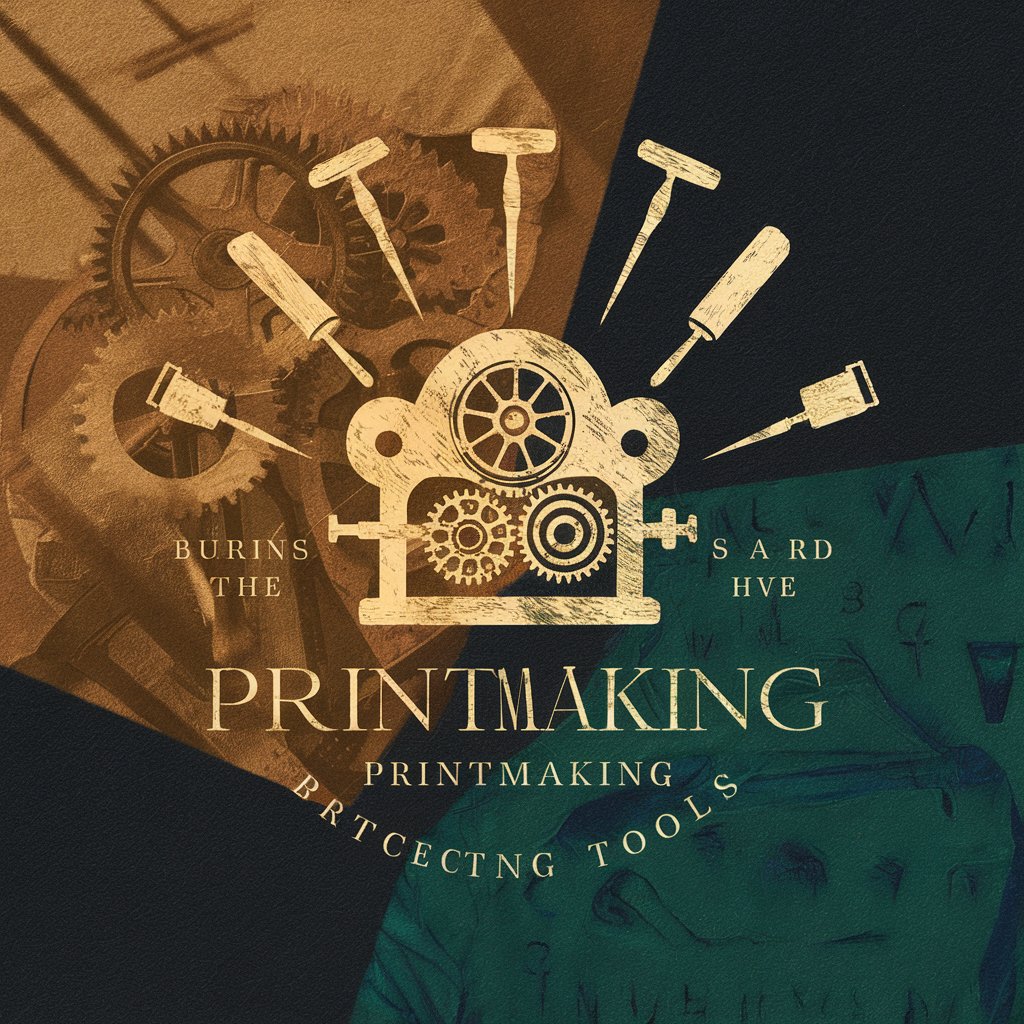Printmaking - Printmaking Exploration

Welcome! Let's dive into the fascinating world of printmaking.
Unleash creativity with AI-driven printmaking insights.
Can you explain the differences between intaglio and relief printing?
Who are some of the most influential printmakers in art history?
What are the essential tools needed for starting with linocut printing?
How does contemporary printmaking integrate with digital technologies?
Get Embed Code
Introduction to Printmaking
Printmaking is an art form that involves the creation of images or artworks by printing, traditionally on paper. Printmaking is distinct for its ability to produce multiple copies of the same piece, known as prints. Each method of printmaking—such as engraving, lithography, woodcut, and screenprinting—offers unique qualities and effects, making this medium highly versatile and expressive. The origins of printmaking trace back to 9th-century China with the development of woodblock printing, spreading to Europe by the 15th century and evolving with technological advancements. Artists like Albrecht Dürer, Rembrandt, and Katsushika Hokusai have famously utilized printmaking, exploring its potential for artistic expression. Modern printmakers continue to innovate, blending traditional techniques with new technologies to push the boundaries of the medium. Scenarios where printmaking shines include limited edition art prints, fabric design, and illustrative storytelling, showcasing its broad applicability in both fine art and commercial arenas. Powered by ChatGPT-4o。

Main Functions of Printmaking
Multiplicability
Example
Creating limited edition art prints that maintain the value and uniqueness of each piece while allowing more collectors to own a piece of the artwork.
Scenario
An artist decides to release a limited edition of 50 screenprints of a popular artwork. This function allows the artwork to be more accessible to fans and collectors, while also preserving the exclusivity and value of the original piece.
Versatility
Example
Utilizing different printmaking techniques to achieve various artistic effects and textures, such as the fine lines of etching or the bold contrasts of woodcuts.
Scenario
A printmaker experiments with lithography to achieve subtle gradations of tone in a landscape piece, contrasting with another project where they use woodcut for its stark, graphic qualities in a series of expressive portraits.
Collaborative Opportunities
Example
Artists working with printmaking studios or workshops to produce prints, benefiting from shared expertise and resources.
Scenario
An artist collaborates with a printmaking studio to create a series of etchings. This collaboration allows the artist to access specialized equipment and technical guidance, fostering a creative synergy that enhances the final outcome of the prints.
Ideal Users of Printmaking Services
Artists and Designers
Individuals seeking to explore the artistic and commercial possibilities of printmaking, including creating artworks for exhibitions, limited edition prints, or design projects. They benefit from the medium's ability to produce multiple copies and its diverse range of expressive techniques.
Art Collectors and Enthusiasts
Those interested in collecting or appreciating prints. They are drawn to the unique qualities of printmaking works, such as the texture, technique, and historical significance of prints, as well as the opportunity to own limited edition art.
Educators and Students
Academic figures and learners interested in the study and practice of printmaking. This group benefits from understanding the historical, cultural, and technical aspects of printmaking, enriching their artistic education and practice.

Getting Started with Printmaking
Begin Your Journey
Start by exploring printmaking without any commitments by visiting a platform offering free trials, such as yeschat.ai, where you can dive in without the need to sign up or subscribe to premium services.
Gather Materials
Before starting your printmaking project, ensure you have the necessary materials. Common essentials include printing ink, brayers (rollers), printing plates, paper, and a press or baren for hand printing. For specific techniques like etching or screen printing, additional specialized tools and materials may be required.
Choose Your Technique
Decide on a printmaking technique that suits your artistic vision. Techniques vary widely, from relief printing (like woodcut and linocut) to intaglio (such as etching and engraving), screen printing, and lithography. Each method has unique characteristics and produces different effects.
Create Your Design
Design your artwork, keeping in mind the specific constraints and opportunities of your chosen printmaking technique. This may involve carving a design into a block, creating a stencil, etching a metal plate, or preparing a stone for lithography.
Print and Reflect
Apply ink to your plate, block, screen, or stone, and transfer the design onto your chosen paper or substrate. Each print (or pull) offers a chance to learn and refine your technique. Experiment with different pressures, inks, and papers to achieve your desired results.
Try other advanced and practical GPTs
Law Buddy
AI-powered Legal Expertise on Demand

CHiBI GIRL BOT
Craft Your Chibi Magic with AI

GPT Store
Empowering innovation with AI

Definitely Private's - Retro Reel CoBot
Your AI-powered film and series guide.

Seasonal
Discover the season's best with AI.

Dad
Empowering Dads with AI-driven Advice

MIDI Design Maestro
Transforming visuals into MIDI magic with AI.

心理學大師.mrwang
Empowering Emotional Wellness with AI

Smoking
Empower Your Quit Journey with AI

Dental Intelligence Expert
Empowering Dental Practices with AI-Driven Insights

Food Allergy Companion
AI-powered allergy insight at your fingertips.

Currency
AI-powered currency exchange clarity

Frequently Asked Questions about Printmaking
What is the best printmaking technique for beginners?
Linocut is often recommended for beginners due to its relatively simple process and the affordability of materials. It involves carving a design into a linoleum block, rolling ink onto the block, and then pressing it onto paper.
Can printmaking be done at home?
Yes, many printmaking techniques, such as linocut, woodcut, and even basic screen printing, can be adapted for home use with minimal equipment. Creating a small, dedicated workspace and investing in essential tools can allow you to explore printmaking from the comfort of your home.
How do I choose paper for printmaking?
The choice of paper depends on the printmaking technique and your desired outcome. High-quality, absorbent papers are generally preferred. For techniques involving heavy ink application or pressure, like etching or woodcut, thicker papers are ideal. Experimentation with different papers is key to finding what works best for your specific needs.
What are some common mistakes in printmaking?
Common mistakes include using too much or too little ink, not applying even pressure during the printing process, and not aligning the paper correctly on the plate or block. Practice and patience are crucial in mastering the printmaking process.
How can I preserve my prints?
Preserve your prints by using acid-free paper and archival-quality inks. After printing, allow the ink to dry completely before storing. Store prints flat in a cool, dry place, protected from direct sunlight. Using archival sleeves or frames with UV-protective glass can also help in preserving the artwork.
